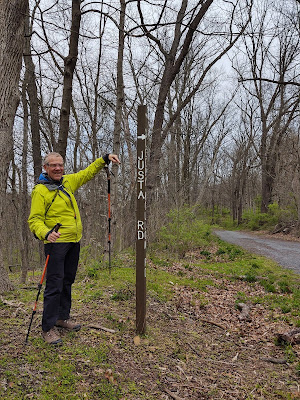April 20, 2020
Hi Blog!
It's been a few days since we last hiked. The weather has been cold and rainy. We are still looking around for a house to buy, but the lockdown makes it impossible to actually tour them. On the bright side, our daughter was able to complete the purchase of her new home, and we will be helping her move in tomorrow. So, for today, we decided to revisit Blue Marsh National Recreation Area and stretch our legs.
Blue Marsh Lake is located northwest of Reading in Berks County, Pennsylvania. This is a multi-purpose project built and maintained by the Philadelphia District, U.S. Army Corps of Engineers. The dam which created the lake was authorized by Congress for flood control, water supply, water quality and recreation. Construction began in 1974 and was completed in 1979. The dam is located on the Tulpehocken Creek and the project's water control practices benefit downstream communities. We started our hike at the Peacock Road trailhead, just as we did on our last hike, but this time we decided to hike south.
This portion of the Blue Lake Border Trail follows several gravel roads. Portions of the land surrounding the lake are still being farmed. It's not often you find a stop sign on your hiking trail.
Did you know lichens occur from sea level to high alpine elevations, in many environmental conditions, and can grow on almost any surface. Lichens are abundant growing on bark, leaves, mosses, on other lichens, and hanging from branches "living on thin air" in rain forests and in temperate woodland. They grow on rock, walls, gravestones, roofs, exposed soil surfaces, and in the soil as part of a biological soil crust. Different kinds of lichens have adapted to survive in some of the most extreme environments on Earth: arctic tundra, hot dry deserts, rocky coasts, and toxic slag heaps. They can even live inside solid rock, growing between the grains. Usually, the lichen in a given spot are relatively uniform in color -- presumably because they are absorbing similar nutrients and living in similar conditions. However, we happened upon colonies of lichen on these two trees which display a rainbow of colors. We like the color combinations in these lichens.
In case you were wondering, this is Just a Road.
The Blue Marsh Lake Trail System is a multi-use trail. The trails are used by horses, bikes and hikers. While we didn't see any horses today, we did get passed by several trailbikers. Overall, the trail was much more populated than we expected. Luckily we had our coronavirus masks.
The trail is surprisingly diverse. From walking through farm fields to meandering along a creek.
The little brook in the photo below is lined with skunk cabbage. This perennial wildflower loves to grow in swampy, wet areas of forest lands. This unusual plant sprouts very early in the spring, and has an odd chemistry that creates its own heat, often melting the snow around itself as it first sprouts in the spring.
The trail then took us along the banks of the lake. The Blue Marsh National Recreation Area covers over 6,200 acres of land, and of this the lake stretches over 1,148 acres of water. It's impossible to see the entire lake as it twists and turns along the old river valley spreading up into the small creek valleys that continue to feed the lake.
Blue Marsh was the name of the village that was located where the lake now is. It was the first settlement in Lower Heidelberg Township. The land was very fertile. It was also a heavily forested area with abundance of wildlife. There were many farms and 18th and 19th century homes. The village also had a church, schoolhouse, post office, and General Store. Residents were put under eminent domain and had no choice but to move out. All that's left are a few foundations like this one.
As we explored the old homestead, we came across this well.
We had to cross several bridges on this part of the trail. The old, rickety bridge below was the longest one.
The next bridge we crossed was over Spring Creek. This creek is healthy enough that Pennsylvania's Fish and Wildlife Agency stocks it with trout. Just as we were reading the stocking notice, a trout lept from the stream in pursuit of a meal. We made a promise to ourselves to come back with our fly rods!
Once we crossed Spring Creek, we began to follow Sleepy Hollow Road as it paralleled this arm of the lake.
It wasn't long before Sleepy Hollow Road was sleeping with the fishes!
We decided to make this our lunch spot and turnaround. While we munched our lunch, we were joined by this little fellow.
On the way back around the Spring Creek arm of the lake, we noticed this farmhouse up on the hill. Spring is finally springing along Spring Creek.
On our return trip, we were passed by several hikers. None of them were wearing masks. We quickly donned our masks and stepped off trail giving them a wide berth. We didn't mind stepping off trail; it gave us a chance to discover some cute little wildflowers.
Just across the channel in the photo below is the old Peacock Road which we hiked last month. This arm of the lake was practically dry back in March. With all the April showers, the channel is filled from bank to bank.
While we hiked six miles, we only covered three miles of trail. Combine that with the three miles we did last time, and we have only hiked six miles of the 36 miles of trails in the Recreation Area. We hope to knock off a few more sections in the weeks to come. Stay tuned.

















No comments:
Post a Comment
Note: Only a member of this blog may post a comment.